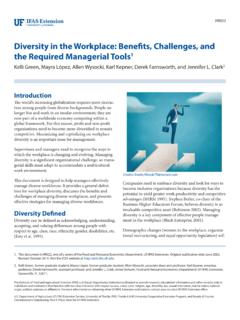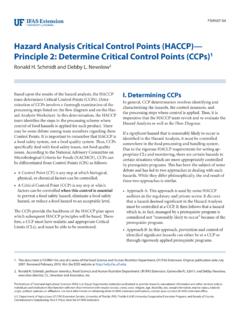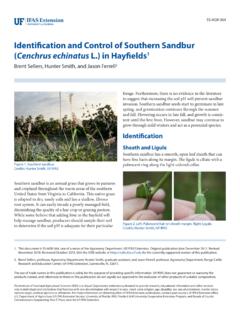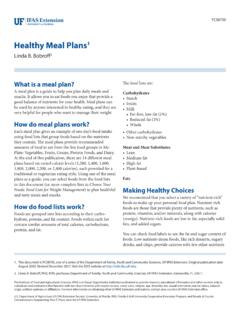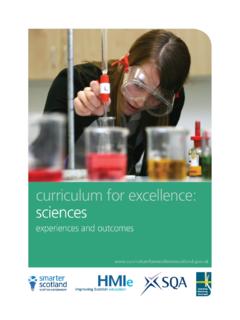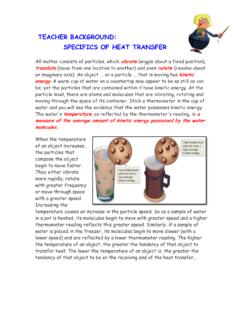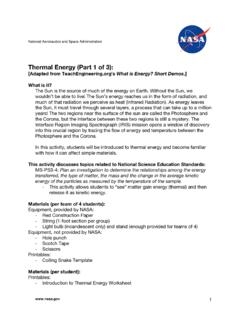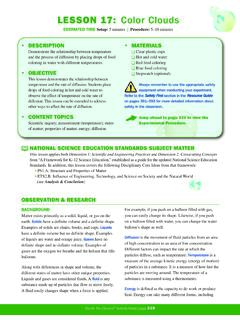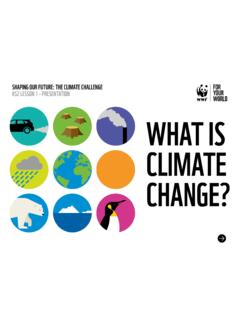Transcription of 3 What Makes Plants Grow? Plant Connections PURPOSE ...
1 What Makes Plants What Makes Plants What Makes Plants GrowGrowGrow??? PURPOSE : To become familiar withwhat Makes Plants : For youth to: identify five basic plantneeds. describe what a plantneeds in order tomanufacture its own food. describe how the nutrientcontent of a soil can beimproved. describe a Plants role in thehydrologic cycle. identify way plantscompete. associate Plants habitatswith Plant TIME: Lesson time may varybased upon learningactivities selected. Mostactivities areapproximately 30 PREPARATION: Read the BACKGROUNDBASICS on What MakesPlants Grow? Review activities andchoose appropriate one(s)to use. Collect and preparematerials for ACTIVITIES 'S EAT! UP! COOL! OF THE FITTEST! HABITATSDO The following are suggestions for using the activities in Lesson 3.
2 The materials needed for each are listed within the activity. Associate Plant needs with Plant growth in NEW BEGINNINGS. Explain how Plants provide us with oxygen in LET'S EAT! Describe the importance of nutrients to Plants in GROW UP! Explain the movement of water in the hydrologic cycle inKEEPING COOL! Identify ways Plants adapt to their environment in SURVIVALOF THE FITTEST! Identify types of Plant habitats in Plant Plant Connections 4H360 Plant Connections , Lesson 3 Introduction REFLECT After completing the activities in this lesson, help youth reflect on what they have learned with these questions: What do Plants need in order to grow? sunlight, water, air, proper temperature, nutrients What is photosynthesis? food manufacturing process in green Plants How do Plants get their water and nutrients?
3 Absorption by the roots Why is water important to Plant growth? used in photosynthesis, transports nutrients, regulates temperature, keeps cells turgid What are some ways Plants adapt to their environments? hard seed coats, chemical defense, thorns and spines Why do Plants need space and shelter? overcrowded areas increase competition for growth limiting growth factors young Plants need shelter from harsh environmental conditions APPLY Help youth learn to apply what they have learned. Name the limiting factors that effect Plant growth. Investigate how the structure and shape of a leaf affects photosynthesis. Start a compost pile!!! Follow the instructions on the COMPOSTING information sheet. Find out what adaption desert Plants have developed to minimize waterloss.
4 Collect and identify seeds around your schoolyard. How was each seeddispersed? What are it s chances of survival? Inspect an artificial habitat (vegetable garden, lawn, hedgerow). Discusswhat the Plants need and how those needs are Connections , Lesson 3 Introduction BACKGROUND BASICS .. What Makes Plants Grow? The vital needs of a Plant are very much like our own - light, water, air, nutrients, and a proper temperature. The relative importance of each of these needs differs widely among Plants . The ability of a Plant species to spread throughout a geographic area is a direct result of its adaption to the abiotic and biotic components of the area. Although most habitat components act on a Plant simultaneously and should be considered together, the lack of one essential component can determine the health of a Plant .
5 This factor, whatever it may be, is referred to as a limiting factor. The concept of limiting factors applies to all aspects of a Plant 's interaction with its habitat. Any factor in the ecosystem can act as a limiting factor. For example, water is important to many species; most species cannot live in desert regions because of lack of water and most cannot live in marshes because of excess water. Extreme temperatures inhibit Plant growth in many regions; lack of warmth in winter is a limiting factor that keeps many species restricted to the tropics. Another limiting factor is often competition from species that use the same resources. Competition is the principal interaction among Plants . Plants of the same species are strongly competitive because they have the same requirements for sunlight, water, and nutrients.
6 Environmental Factors Affecting Plant Growth Light Light reaching the surface of a Plant is either absorbed, reflected, or transmitted. Energy, in the form of sunlight is one of the driving forces in the chemical reaction known as photosynthesis. Photosynthesis is the process by which green Plants manufacture food, mainly sugars, from carbon dioxide and water in the presence of chlorophyll (a green pigment), utilizing light energy and releasing oxygen and water. Together the quality, quantity, and duration of light influences Plant growth. Plants grown in direct sunlight are typically compact, where as those in shade are taller and elongated. Seeds may start to grow (germinate) without light, but the Plant growing from it must have light if it is to continue to grow.
7 Moisture Water is essential for life, it is one of the most important requirements for Plant growth. Water is the main component in Plants cells, it keeps the Plant turgid (stiff), it is used in photosynthesis, and transports nutrients throughout the Plant . Plants also use water to lower leaf temperature, increase mineral absorption, and pull water from the roots to the top of the Plants through a process known as transpiration. The hydrologic cycle. The hydrologic cycle is the cycle of water in the environment. Water moves in a series of processes. Water moves by precipitation, evaporation, transpiration, and condensation. The sun provides the energy for water to move in a cycle. All water on earth is part of the water cycle regardless if it is in a lake, our bodies, food, or underground.
8 Precipitation (rain, snow, hail, etc.) either infiltrates the soil or runs into nearby ditches or streams. Water on the surface of a lake or pool will eventually evaporate from the sun s heat and become water vapor. This vapor then becomes part of a cloud and condenses to form precipitation. Plants release water vapor into the atmosphere by transpiration. Plant Connections , Lesson 3 Introduction Air One of the raw materials used in photosynthesis is carbon dioxide. The content of carbon dioxide in the atmosphere is relatively stable at about percent, a seemingly small amount but totaling roughly 2,000,000,000,000 tons in the atmosphere surrounding the earth. Carbon dioxide is continually being added to the air by respiration of Plants and animals, decaying organic materials, combustion of fuels, and volcanic activity.
9 Carbon dioxide diffuses through the stomata (pores or openings in a Plants epidermis) from the atmosphere into the intercellular spaces of the leaf. Wind is air in motion and can be both beneficial and harmful to Plants . Wind can benefit Plants by accelerating the transfer of heat from leaf surfaces and increasing circulation in areas prone to fungal growth. Wind can be detrimental to Plants by causing excessive drying, scattering of weed seeds, and sometimes destroying Plants . Proper temperature The temperature of the atmosphere is the result of the transfer of heat from the earth s surface to the surrounding air. Temperature varies with latitude, altitude, and topography. The climate and temperature of an area determines what kinds of Plants will grow.
10 The ability of a Plant to withstand cold temperatures is known as cold hardiness while Plants that can not tolerate cool weather are known as tender. In the natural environment, temperature is continually changing. Nutrients In addition to carbon dioxide and water, Plants need 17 different nutrients to maintain growth. Although carbon, oxygen, and hydrogen are obtained from the air, most nutrients that a Plant needs must be present in the soil or growing medium. These elements are divided into macro and micro elements. Macro nutrients needed in the largest amounts are nitrogen (N) for healthy foliage, phosphorus (P) for flower development, and potassium (K) for root growth. The soils in which Plants grow consists of a mixture of mineral materials, organic matter, water, and air in varying proportions.

